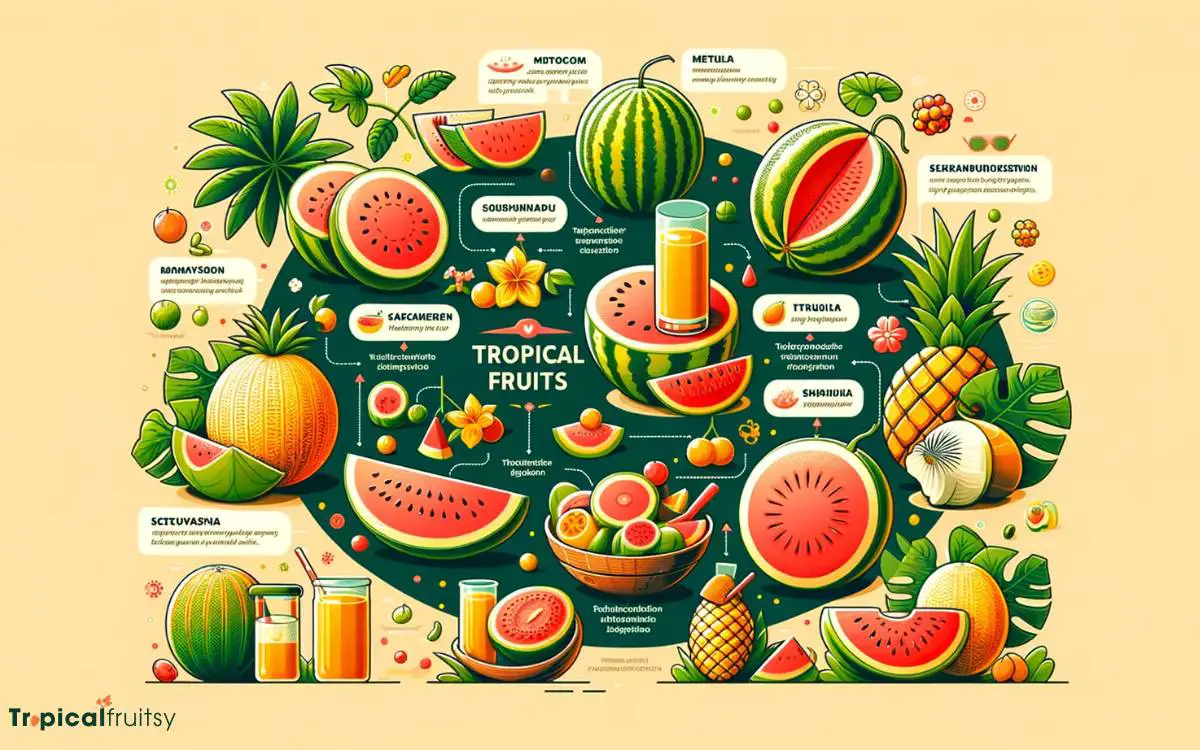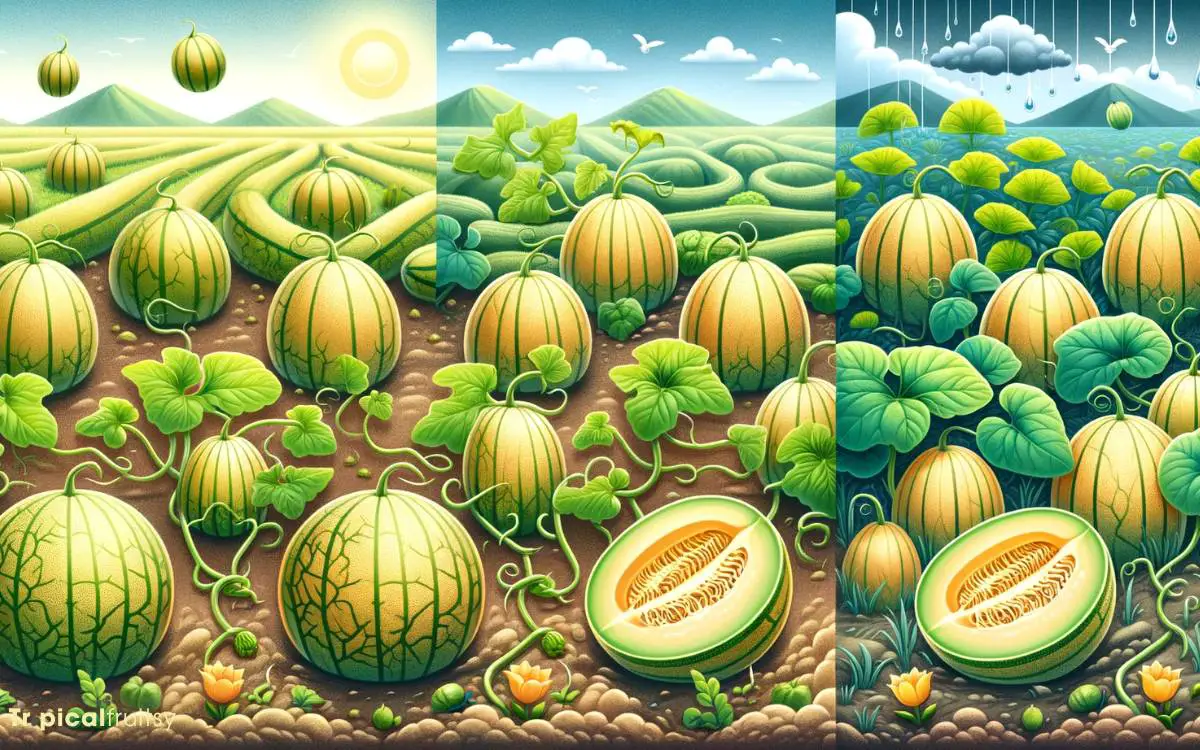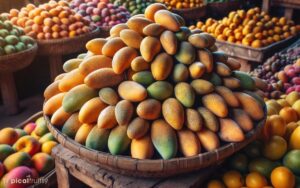Is Melon a Tropical Fruit? No!
Melons are not typically classified as tropical fruits. While melons enjoy warm weather for growth, they are cultivated in a variety of climates, including temperate zones.
Melons belong to the Cucurbitaceae family, which includes both tropical and non-tropical plants, and they have a broader geographical range than true tropical fruits.
Tropical fruits are generally defined as fruits that originate from regions within 10 degrees north and south of the Equator, where the climate is warm and humid throughout the year.
Melons, on the other hand, have different species that adapt to various climates:
This adaptability indicates that melons are not strictly tropical fruits. Melons’ versatility in growing across different climate zones underlines their distinction from exclusively tropical fruits.

Key Takeaway
Melon Types, Preferred Climates, and Origins
| Melon Type | Preferred Climate | Tropical or Non-Tropical | Origin |
|---|---|---|---|
| Cantaloupes | Warm, temperate | Non-Tropical | Middle East, India |
| Honeydews | Warm, temperate | Non-Tropical | Middle East, West Africa |
| Watermelons | Warm, adaptable | Both | Southern Africa |
| Winter Melon | Cooler, temperate | Non-Tropical | Southeast Asia |
Defining Tropical Fruits

Within the context of horticulture, tropical fruits are typically defined as those that originate in regions with a tropical climate, where the environment is characterized by high temperatures and abundant rainfall throughout the year.
These fruits have adapted to flourish under such conditions and often exhibit features like thick skins to prevent moisture loss and vibrant colors attracting pollinators in dense foliage. Common examples include bananas, mangoes, pineapples, and papayas.
Their growth cycle is generally synchronized with the wet and dry seasons, ensuring optimal development and fruiting.
The categorization of tropical fruits extends beyond mere climatic origin; it also encompasses the plant’s botanical requirements and physiological adaptations to its native habitat.
As we delve into the classification of melons, it is essential to explore the varieties that may align with these tropical characteristics.
Melon Varieties Explored

Numerous varieties of melons exist, each with distinct climatic preferences, ranging from temperate to tropical regions.
The Cucumis melo species, commonly referred to as muskmelons, encompasses a breadth of cultivars including the widely known cantaloupes and honeydews.
Cantaloupes, characterized by their netted rind and succulent orange flesh, thrive in warm, temperate zones.
Honeydews, noted for their smooth rinds and light green flesh, require similar conditions but can also prosper in more humid, subtropical areas.
Watermelons, classified under Citrullus lanatus, are adapted to warmer climates and are often associated with tropical and subtropical environments.
They exhibit a diverse range of sizes and flesh colors, from the classic red to the less common yellow and orange varieties.
Each melon type’s agricultural viability is contingent upon careful selection of an appropriate climatic niche to ensure optimal growth and fruit development.
Melon Growth and Climate

Melons require specific climatic conditions to flourish, with most varieties preferring a consistent temperature range between 65 to 95 degrees Fahrenheit.
This optimal thermal window is crucial for the proper germination, flowering, and fruit set of the plant. Suboptimal temperatures, either cooler or warmer, can lead to reduced yield and fruit quality.
Moreover, melons demand a well-drained soil with a neutral to slightly acidic pH, rich in organic matter to support their vigorous growth.
Adequate sunlight is essential for photosynthesis, which drives sugar accumulation in the fruits, contributing to their sweetness.
Irrigation must be judiciously managed to maintain soil moisture without waterlogging, as melons are sensitive to both drought and excessive moisture.
Understanding these agroclimatic requirements is indispensable for successful melon cultivation.
Common Melon Misconceptions

Many people mistakenly categorize all melons as tropical fruits, overlooking the diverse climatic needs of different melon varieties.
Melons, as a group, demonstrate a wide range of environmental adaptability, which contributes to the following misconceptions:
- All melons thrive in tropical climates
- Cucumis melo (cantaloupes, honeydew) prefer warm, temperate regions
- Citrullus lanatus (watermelon) can grow in semi-arid zones
- Melons cannot tolerate cold
- Certain varieties have been selectively bred for cooler climates
- Some melon types exhibit frost resistance to a degree
Understanding the nuanced requirements of melon cultivation is essential for accurate classification.
Their adaptability often leads to mislabeling within popular discourse, necessitating a more discerning approach to their botanical categorization.
How Is Melon Not Considered a Tropical Fruit?
Melon, despite its sweet and juicy flavor, is not considered a tropical fruit. It belongs to the Cucurbitaceae family and is commonly cultivated in temperate regions. While melons come in various types and colors, including the explore yellow tropical fruit, they are not classified as tropical due to their growing conditions.
Melons and Tropical Identity

The term ‘tropical fruit’ often conjures images of exotic locales, yet its application to melons requires a nuanced understanding of their botanical classification and growth patterns.
Although melons are often associated with warm, sunny climates, not all varieties fit the strictest definitions of tropical fruit.
| Classification | Description |
|---|---|
| Botanical Family | Cucurbitaceae, which includes cucumbers. |
| Growth Requirement | Warm temperatures, but not exclusively tropical. |
| Geographic Origin | Africa, with some types from temperate zones. |
| Seasonality | Typically summer fruit in temperate climates. |
Melons thrive in climates that provide sustained warmth, but they are adaptable and can be found in both tropical and temperate zones.
It is essential to distinguish between the climatic preferences of melon varieties and the conventional categorization of tropical fruits, which is typically limited to species originating in tropical regions.
Conclusion
While melons thrive in warm climates and share some characteristics with tropical fruits, they do not strictly fit within the botanical classification of tropical fruits.
Melons, including popular varieties such as cantaloupe and watermelon, are more accurately classified as temperate fruits.
A notable statistic is that over 25 million tonnes of watermelons are produced globally each year, underscoring their widespread cultivation beyond tropical regions and challenging the notion of their exclusive tropical identity.






